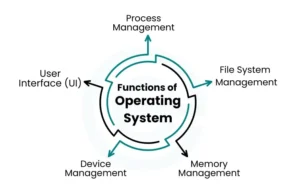Functions of an Operating System (OS)
An Operating System (OS) is not just the software you see on your screen—it is the system’s command center, managing everything from memory to input devices. Understanding the core functions of an OS is essential to grasp how a computer works behind the scenes. These functions ensure that the computer system operates efficiently and securely.
1. Process Management
The OS is responsible for handling multiple processes running simultaneously. Each time you open an application, a process is created.
- It creates, schedules, and terminates processes.
- Manages CPU time so each program runs without blocking others.
- Ensures processes can communicate (Inter-Process Communication) and do not interfere with each other.
This function allows users to multitask—for example, listening to music while browsing the internet.
2. Memory Management
Memory is limited, and multiple programs need access to it. The OS ensures optimal usage of system memory (RAM).
-
Allocates memory to active processes.
-
Keeps track of each process’s memory use.
-
Frees up memory when it's no longer needed.
It ensures that one program does not corrupt another’s data and that the system avoids crashes due to memory overflow.
3. File System Management
The OS manages how data is stored and retrieved on storage devices like hard drives or SSDs.
- Organizes files in directories/folders for easier access.
- Keeps track of file locations and permissions.
- Provides a structure (like FAT, NTFS) for storing files.
Users see this in action when saving documents, organizing files, or searching for data.
4. Device Management
All external and internal devices (keyboard, mouse, printer, etc.) communicate with the OS through device drivers.
- Controls and coordinates device usage.
- Sends commands from software to the correct hardware.
- Handles input and output operations efficiently.
This function ensures you can type, print, click, and connect seamlessly with your system.
5. Security and Access Control
Protecting user data and ensuring secure system usage is a critical role of the OS.
- Implements user authentication using passwords or biometrics.
- Restricts access to system files and resources.
- Manages encryption, firewalls, and system updates to guard against threats.
The OS acts as a gatekeeper, ensuring only authorized users can perform specific tasks.
6. User Interface (UI) Management
Most modern OSs provide a graphical interface so users can interact with the system easily.
- Displays windows, icons, menus, and buttons.
- Translates user inputs (clicks, taps, commands) into system actions.
Whether it’s Windows, macOS, or Android, the UI makes computers accessible to everyone—not just programmers.
Summary
The Operating System performs multiple critical functions simultaneously—managing memory, processes, files, devices, security, and user interfaces. It ensures the system remains stable, efficient, and user-friendly. Without the OS, even the most powerful hardware would be inaccessible and unusable to the average user.
